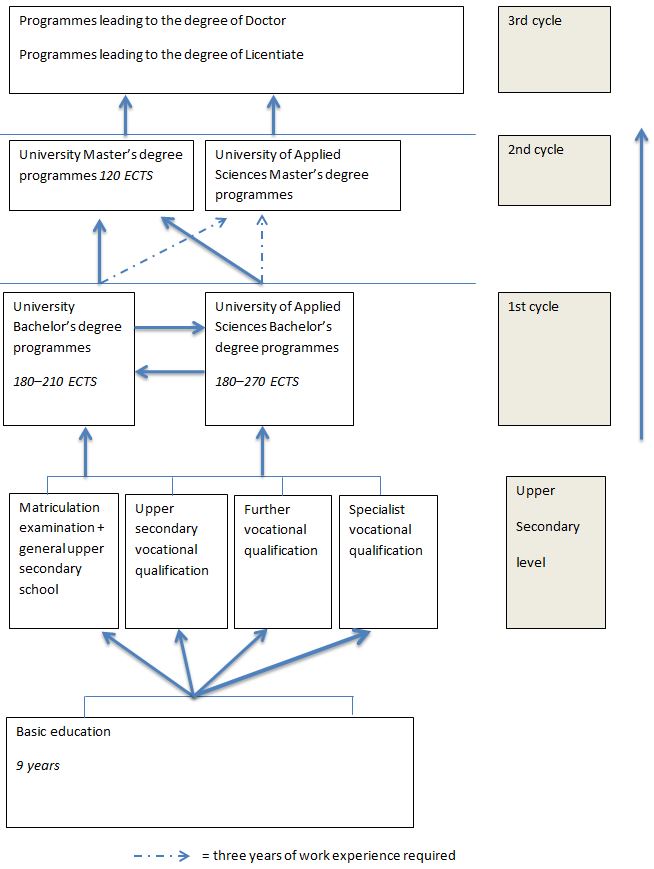1. Diagram of the Finnish higher education system

2. Types of higher education institutions
| National name | English name | Accreditation | NQF level | Types of qualifications offered |
|---|---|---|---|---|
| Yliopisto/universitet | University | See section 5 below | 6-8 | Bachelor’s degree, master’s degree, doctoral degrees |
| Maanpuolustuskorkeakoulu/ Försvarshögskolan | National Defence University | See section 5 below | 6-8 | Bachelor’s degree, master’s degree, doctoral degrees |
| Ammattikorkeakoulu (AMK) / yrkeshögskolan (YH) | University of applied sciences (UAS) | See section 5 below | 6-7 | Bachelor’s degree, master’s degree |
| Högskolan på Åland | Åland University of Applied Sciences | See section 5 below | n/a | Bachelor’s degree |
| Poliisiammattikorkeakoulu/ Polisyrkeshögskolan | Police University College | See section 5 below | 6-7 | Bachelor’s degree, master’s degree |
- List of the universities – Ministry of Education and Culture
- List of the universities of applied sciences – Ministry of Education and Culture
3. Types of higher education
| Qualification | Qualification in English | EQF / cycle | Length / ECTS | Access requirement | Access to further study |
|---|---|---|---|---|---|
| Kandidaatin tutkinto / kandidatexamen | Bachelor’s degree | 6 / 1st cycle | 180 ECTS * | Upper secondary qualification | Master’s degree |
| Ammattikorkeakoulututkinto (AMK)/ yrkeshögskoleexamen (YH) | Bachelor’s degree | 6 / 1st cycle | 180-270 ECTS | Upper secondary qualification | Master’s degree |
| Maisterin tutkinto / magisterexamen | Master’s degree | 7 / 2nd cycle | 120 ECTS ** | Bachelor’s degree | Doctoral degree |
| Ylempi ammattikorkeakoulututkinto / högre yrkeshögskoleexamen | Master’s degree | 7 / 2nd cycle | 60-90 ECTS *** | Bachelor’s degree + 3- years’ work experience | Doctoral degree |
| Lisensiaatin tutkinto / licentiatexamen | Licentiate degree | 8 / 3rd cycle | N/A | Master’s degree | n/a |
| Tohtorin tutkinto / doktorsexamen | Doctor degree | 8 / 3rd cycle | N/A | Master’s degree | n/a |
* Exception: The extent of studies required for the degree of
Bachelor of Fine Arts shall be 210 credits. The university must arrange
the education to enable the student to complete the degree in three and
a half years of full-time study.
** In the fields of Medicine and Dentistry the university may arrange the education leading to the second-cycle university degree without including a first-cycle university degree in the education. In Medicine the degree consists of 360 credits (6 years of full-time study) and in Dentistry the degree consists of 300 credits (5 years of full-time study).
*** Exception: The extent of studies required for the degree of
Master of Police Services is 120 ECTS.
4. Qualifications framework
The National Framework for Qualifications and Other Competence Modules entered into force March 2017. It is based on the European Qualifications Framework (EQF).
Finnish higher education qualifications are placed at the following levels of competence in the National Qualifications Framework (FINQF):
- University and UAS Bachelor’s degrees at level 6
- University and UAS Master’s degrees at level 7
- Scientific, artistic and professional postgraduate degrees from universities, e.g. Licentiate and Doctoral degrees at level 8
5. Quality assurance and accreditation
The Finnish Education Evaluation Centre (FINEEC) is responsible for the evaluation of education provided by universities and universities of applied sciences in Finland. The three key evaluation types are the audits of higher education institutions’ (HEIs) quality systems, thematic evaluations of the education system and engineering degree programme reviews.
Formerly this task was carried out by the Finnish Higher Education Evaluation Council (FINHEEC).
6. Upper secondary qualifications giving access to higher education
This table includes only qualifications that are currently part of the Finnish education system.
| Qualification | Orientation | Access to further study |
|---|---|---|
| Ylioppilastutkinto / studentexamen | General upper secondary education | All first cycle programmes |
| Ammatillinen perustutkinto (120 ov) /yrkesinriktad grundexamen (120 sv) / as a school based qualification requires three years of study | Vocational qualification, available in eight fields and in more than in 60 professions | All first cycle programmes |
| Ammattitutkinto / yrkesexamen | Vocational qualification, available in eight fields and in more than in 60 professions | All first cycle programmes |
| Erikoisammattitutkinto / specialyrkesexamen | Vocational qualification, available in eight fields and in more than in 60 professions | All first cycle programmes |
The completion of general upper secondary education (lukion oppimäärä/ gymnasiets lärokurs) gives eligibility to apply to a university of applied sciences. The document is titled “Lukion päättötodistus” / “Avgångsbetyg från gymnasiet”.
Competence based qualifications in upper secondary vocational education (for adults)
In order to complete a competence-based qualification, candidates must demonstrate certain skills and competence required in the profession. These skills are outlined in the Requirements of Competence-based Qualifications defined by the Finnish National Agency for Education (Opetushallitus / Utbildningsstyrelsen). Vocational modules are defined in collaboration with representatives of business life and are directly based on real-life work tasks.
There are three levels of competence based qualifications:
- Vocational qualifications which indicate competence to enter employment in the field.
- Further vocational qualifications which indicate the vocational skills required of skilled workers in the field.
- Specialist vocational qualifications which indicate a command of the most demanding tasks in the field.
